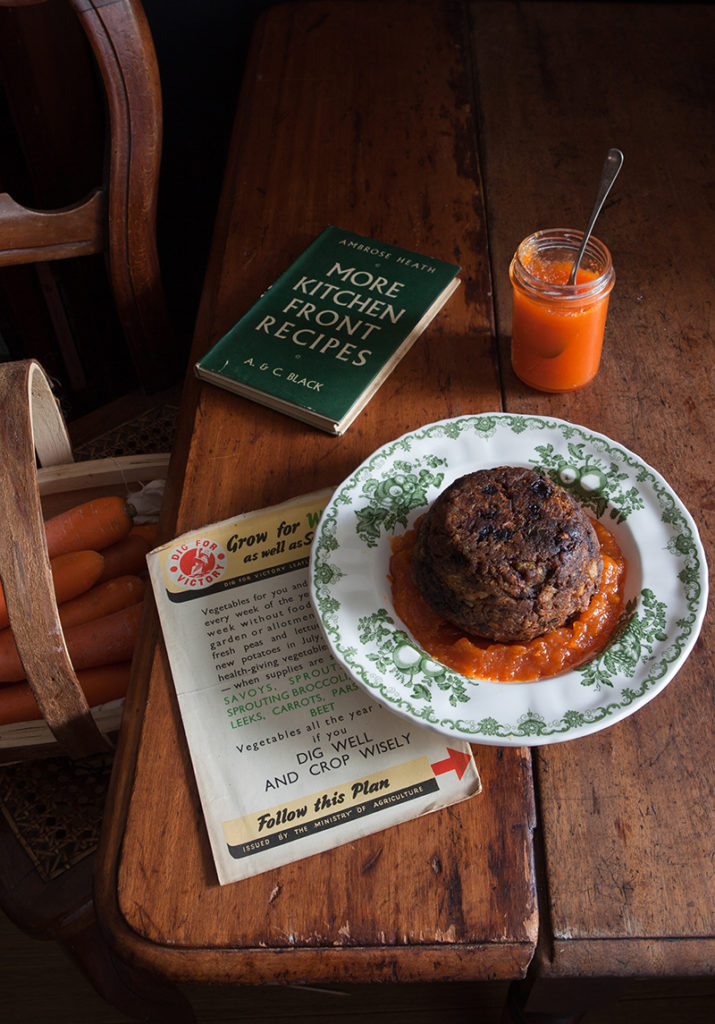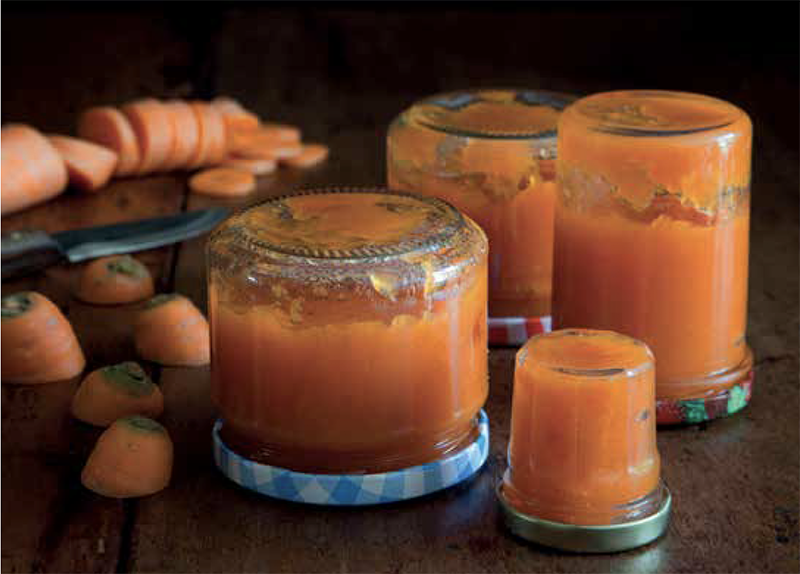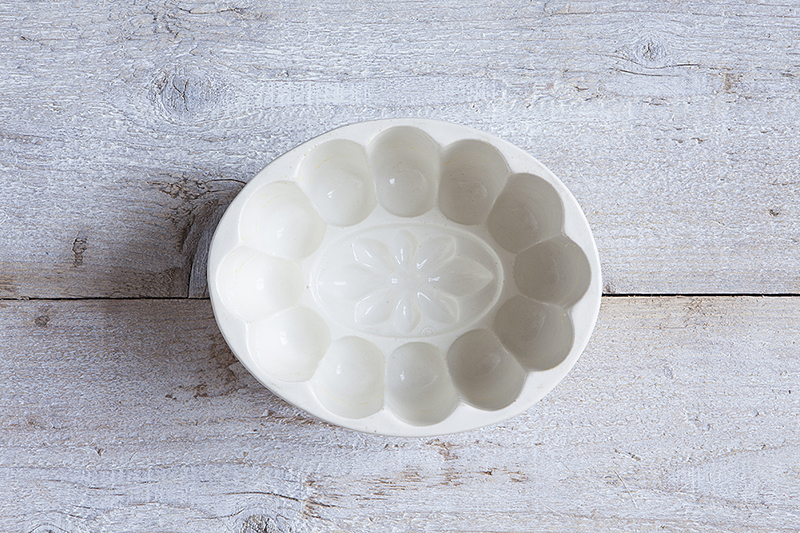The post War & Peace Pudding with Mock Apricot Jam – for the 75th anniversary of ‘Victory in Europe Day’ A Recipe from Pride and Pudding appeared first on Miss Foodwise.
]]>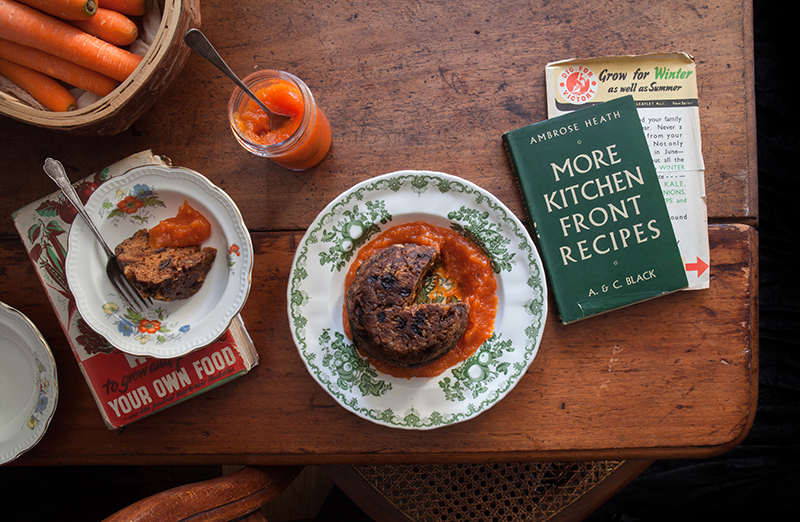
Today 8 may I’ll be showing two war-time recipes over at London’s Borough Market for the 75th anniversary of ‘Victory in Europe Day’ or the end of WWII.
While world wars and lockdown are very different, both have led to difficulties obtaining certain ingredients. We’ll be looking at two war-time recipes that were actually promoted by the Ministry of Food because there was an overload of carrots and potatoes. Recipe booklets were made to help cooks to whip up a variety of recipes with carrots and potatoes and other austere but often very delicious creative recipes
We’ll be cooking up “War & Peace Pudding” with “Mock apricot” carrot jam, both wartime recipes from my book Pride and Pudding. Tune into our IGTV over at Borough Market on Instagram
During wartime, ingredients for plum pudding were hard to come by so the Ministry of Food produced a recipe for a ‘War and Peace Pudding’ made of carrots, potatoes and suet.
The recipe also appeared as a ‘Wartime Christmas Pudding’. Carrots and potato were both promoted by the Ministry of Food because they grew easily and were plentiful, and therefore they were important to keep people healthy. Potato was often used as an alternative to other ingredients in dishes and carrots were used because of their sweet flavour. At some point ‘carrots on sticks’ were sold to children instead of ice cream – which was banned – and ‘toffee carrots’ replaced toffee apples.
This is an excellent pudding and the “mock apricot” carrot jam absolutely sublime and a great novelty for when dinner parties are back allowed!
War & Peace Pudding
Makes 1 pudding in a 14 cm (No. 42) diameter basin (mould)
75 g carrots, grated
100 g potatoes, grated
85 g plain (all-purpose) flour
30 g fresh breadcrumbs
30 g shredded suet
1 teaspoon ground allspice
or mixed spice
1 teaspoon bicarbonate
of soda (baking soda)
2 tablespoons warm water
1 tablespoon mixed dried
fruit, soaked in water, rum or brandy
Method
Preheat the oven to 160C. Prepare the pudding basins for steaming
In a large bowl, combine the carrot, potato, flour, breadcrumbs, suet and allspice. Dissolve the bicarbonate of soda in the water and add to the mixture. On a lightly floured work surface, knead into a ball. Don’t be alarmed if the mixture seems dry, it will come together after kneading it for a few minutes.
Work through the mixed dried fruit and roll the dough into a ball. Put the ball into the prepared pudding basin and push it down. Close the pudding basin off with baking paper and wrap in tin foil. Place on an inverted saucer in a pot large enough for the pudding basin and pour in boiling water to come up halfway the sides of the basin. Close the lid, cover any steaming holes the lid might have and steam for 2 hours.
Serve with carrot jam
“Mock apricot” Carrot jam
500 g carrot puree made from boiled carrots
500 g raw sugar
juice of 1 lemon
zest of 1/2 lemon, grated or cut into fine strips
5 apricot kernels
2 tablespoons brandy
Put the carrot puree in a large saucepan and bring to the boil. Add the sugar, lemon juice and zest and apricot kernels.
Boil until the mixture has thickened and gels quickly when spooned onto a cold plate.
Remove from the heat and take out the apricot kernels if you can spot them. Stir the brandy through the jam and decant into sterilised jars. Close the jars and turn them upside down to cool.
The jam has a hint of apricot; it was marketed as mock apricot jam.
This jam doesn’t keep long and must be stored in the fridge.
The post War & Peace Pudding with Mock Apricot Jam – for the 75th anniversary of ‘Victory in Europe Day’ A Recipe from Pride and Pudding appeared first on Miss Foodwise.
]]>The post Mini Chelsea Bun Crowns appeared first on Miss Foodwise.
]]>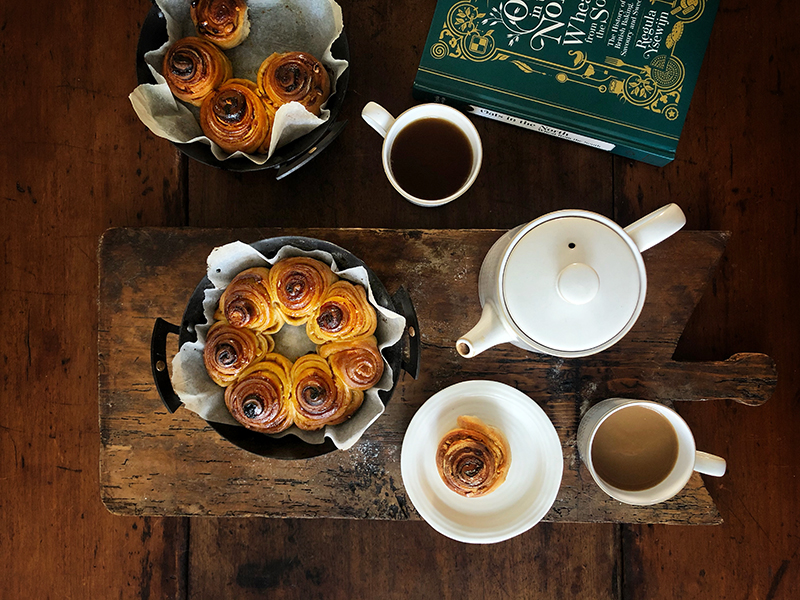
I’ve been sharing videos and easy baking ideas on my Instagram @Missfoodwise during these strange times, some will be handy to make things easier for you for when you want to get some thing beautiful and delicious on the table quick. I’ve posted a few recipes from my new book Oats in the North Wheat from the South – which came out in full lockdown and saw all my events in the UK cancelled. Luckily I was able to do my BBC Womans’ hour interview over the phone as I would have been sad to miss is.
I also posted some ideas for overnight doughs so you can prep before bed and bake in the morning for breakfast or lunch. This is one of those bakes (there is also overnight bread buns and quick pan pizza for same day baking) that looks great on your table, looks great to give as gifts – I’ve gifted one of the crowns to my neighbours who are doctors and can use some unexpected cheer and sweetness right now.
These buns are a variation on my Chelsea buns from the book but made so that you can leave the dough at room temperature overnight. If you want to bake them to eat on the same day, add more yeast as explained below.
Makes 3 small crowns
- 6 g dried yeast (15 g if you are baking on the same day, then first rise is 1 hour)
- 300 ml full-fat milk, room temp (lukewarm if you’re baking on the same day)
- 500 g strong white bread flour
- 60 g raw (demerara) sugar or white sugar
- 1 tsp ground cinnamon (or use pumpkin spice instead of the spices)
- 1/4 tsp ground mace
- ¹⁄8 tsp ground coriander
- 70 g butter, at room temperature, cubed
- 1 egg
- 5 g fine sea salt
For the filling
- 3-4 tbsp lemon curd
- 2 tbsp fine sugar
- Chopped hazelnuts
- Milk for brushing
For the sugar syrup
- 60 g (2. oz) raw (demerara) sugar or
- white sugar
- 5 tbsp water
- caster (superfine) sugar, for sprinkling
Method
Combine the flour, yeast, sugar and spices in a large bowl or the bowl of an electric mixer fitted with a dough hook and put the butter on top. Pour half of the milk over the butter and start kneading. When the milk and butter are completely absorbed, add the rest of the milk , along with the egg. Knead for 5 minutes, then let the dough stand for a few minutes (at this point it will be very wet). Add the salt and then knead for 10 minutes, scraping the dough off the dough hook and side of the bowl if needed, until the dough has come together in a smooth and elastic dough that is not too dry but also not terribly wet.
Cover the dough and set aside for 1 hour until it has doubled in quantity – OR WHEN USING THE OVERNIGHT METHOD: cover the bowl with the dough with plastic and leave until te morning at room temperature.
Line the baking tin or pan(s) with baking paper. Towards the end of the resting time, or in the morning, preheat the oven to 210°C
Divide the dough in two and shape one piece to a rectangle, roll out as thinly as possible, making sure you keep the shape (I’ve posted a video on my instagram feed @Missfoodwise)
Spread the dough with half the lemon curd, sprinkle over half the sugar and cover in half the chopped nuts. Divide lengthwise in 3 cm strips and roll those over to fill your tin(s) or pan(s) with. Do the same with the other half of the dough and then brush the buns all over with milk. These buns do not need to rise as we want the layers thin, so you can now immediately bake them! However if you like you can of course let them rest for an hour, or more, and your layers won’t be as thin.
Bake for about 20 minutes until golden brown, meanwhile prep the sugar syrup by heating the sugar and water in a small saucepan until the sugar has dissolved. Brush the buns with the sugar syrup as soon as they come out of the oven and then decorate with either coarse sugar, tiny sugar nibs, more nuts or leave plain and shiny!
The next day the buns are easily reheated in a hot oven for 5 minutes, they’ll taste freshly baked!
Enjoy!
Follow me on Instagram to stay up to date with videos etc, my new book is for sale over here >
The post Mini Chelsea Bun Crowns appeared first on Miss Foodwise.
]]>The post Jaune Mange appeared first on Miss Foodwise.
]]>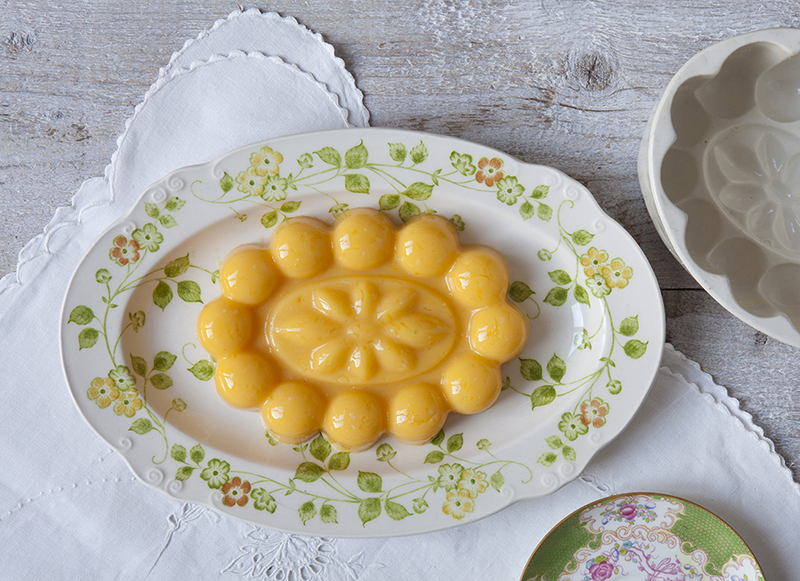 Jaune Mange jelly is the yellow sister to the ancient delicacy called Blanc Mange which means ‘white food’. It is one of the most international early dishes of European cuisine. From the Middle Ages onwards the name of this dish in its various forms – blanc mange, blanc manger, blamange, manjar branco, biancomangiare – can be found in most European cookery books.
Jaune Mange jelly is the yellow sister to the ancient delicacy called Blanc Mange which means ‘white food’. It is one of the most international early dishes of European cuisine. From the Middle Ages onwards the name of this dish in its various forms – blanc mange, blanc manger, blamange, manjar branco, biancomangiare – can be found in most European cookery books.
It is believed by many food historians that the earliest recipe for blancmange dates back to the twelfth century. Two recipes for blancmange also feature in the earliest English cookery text, The Forme of Cury from C1390. By 1395, two recipes for blancmange can be found in the Viandier manuscripts, the first French cookbook: one is a dish for the sick, the other is a multicoloured dish, which is at odds with the name’s literal meaning.
This recipe uses seville orange juice, while others recommend lemon and lemon peel for flavour and colour. Later recipes by J.H. Walsh in The British Cookery Book (1864) instruct the cook to use sherry or ‘raisin-wine’. Because the eggs give this jaune mange a set already, you don’t need to use as much gelatine as you would for a blancmange.`
Jaune Mange
Boil one ounce of isinglass three quarters of a pint of water, till melted, strain it; add the juice of two Seville oranges, a quarter of a pint of white wine, the yolks of four eggs, beaten and strained, sugar to the taste; stir it over a gentle fire till it just boils up; when cold put it into a mould or moulds; if there should be any sediment, take care not to pour it in.
Charlotte Mason, The Lady’s Assistant, 1773
Makes enough for a fancy 400 ml (14 fl oz) mould
What do you need
- 220 ml (7. fl oz) white wine
- 1 teaspoon sugar
- 3 egg yolks
- 4 gelatine leaves
- juice of 2 seville oranges (or plain oranges, it will just be more sweet but not too sweet, don’t worry)
Method
In a small saucepan, bring the wine and sugar to a simmer. In a separate bowl, whisk the egg yolks. Soak the gelatine leaves in the orange juice until soft.
Begin whisking the warm wine mixture into the egg yolks, followed by the soaked gelatine and juice.
Allow to cool but not set, then pour into a mould that you have rinsed and not wiped dry and allow to set for 6 hours or overnight. The smaller the mould, the shorter the setting time.
To unmould, wet one of your hands and use it to loosen the jelly. Allow the jelly to slide out onto a wet plate (if the plate is wet, you can easily move the jelly around if necessary).
From my book ‘Pride and Pudding – the history of British puddings, savoury and sweet’ (Murdoch Books)
Happy new year!
The post Jaune Mange appeared first on Miss Foodwise.
]]>